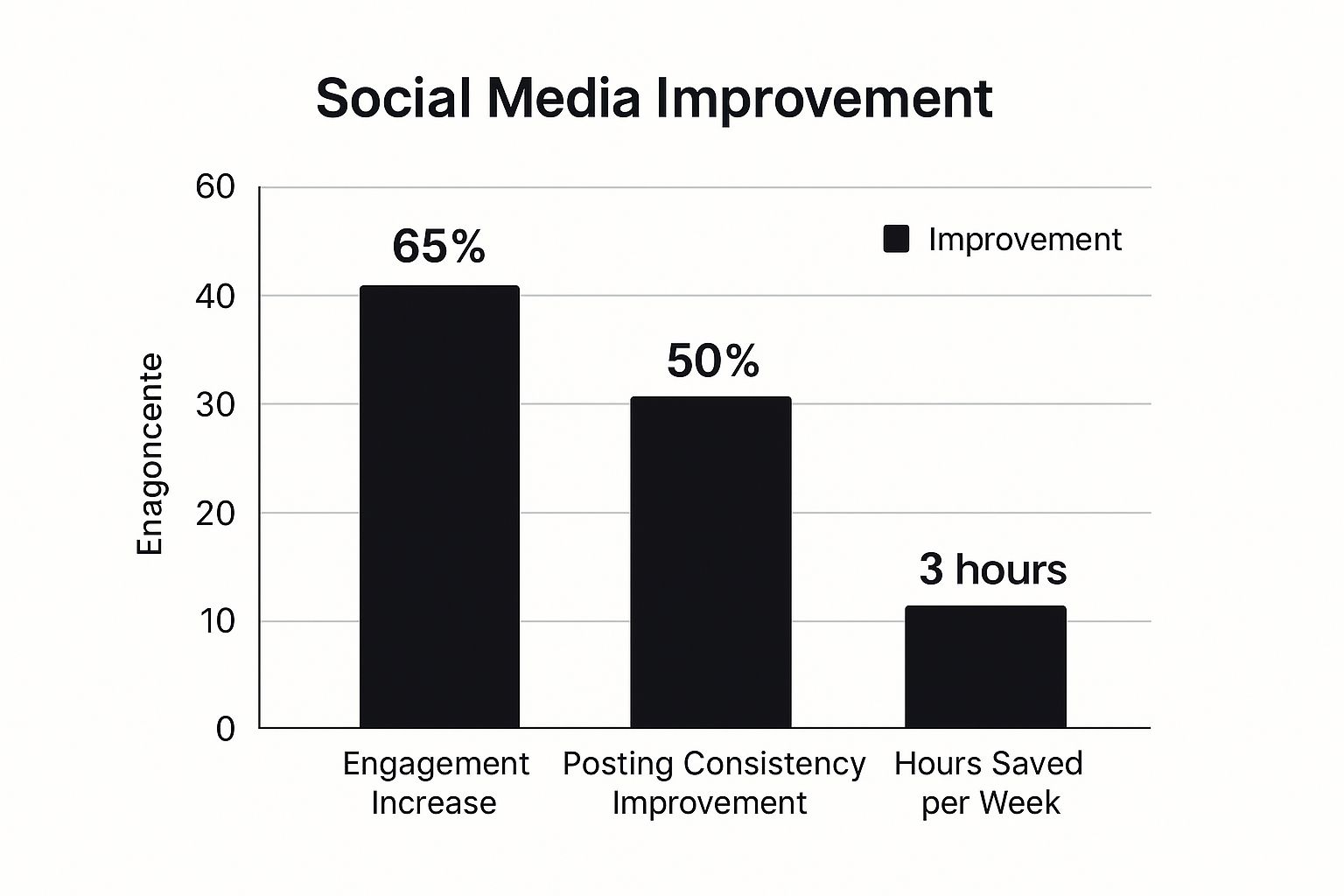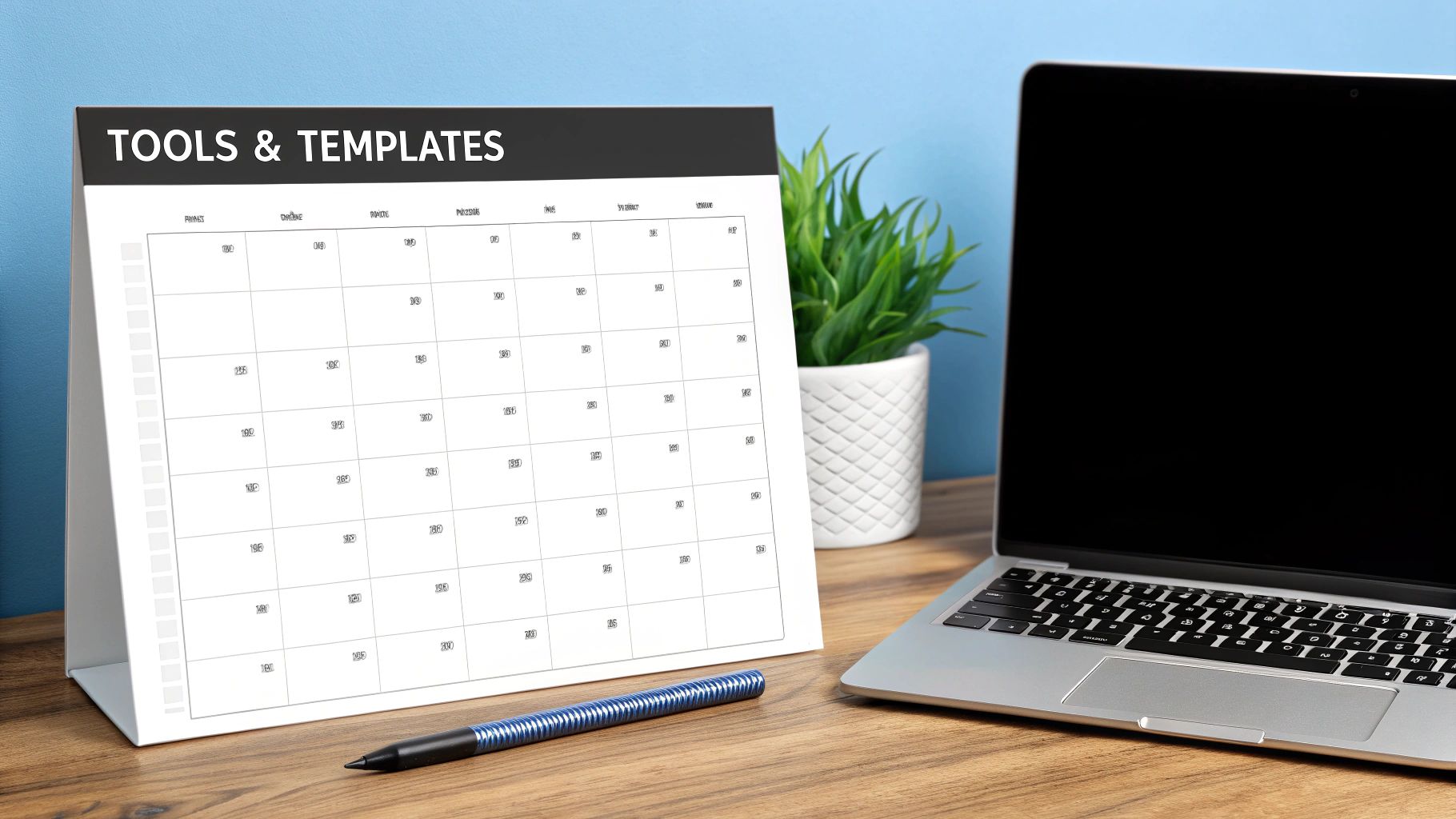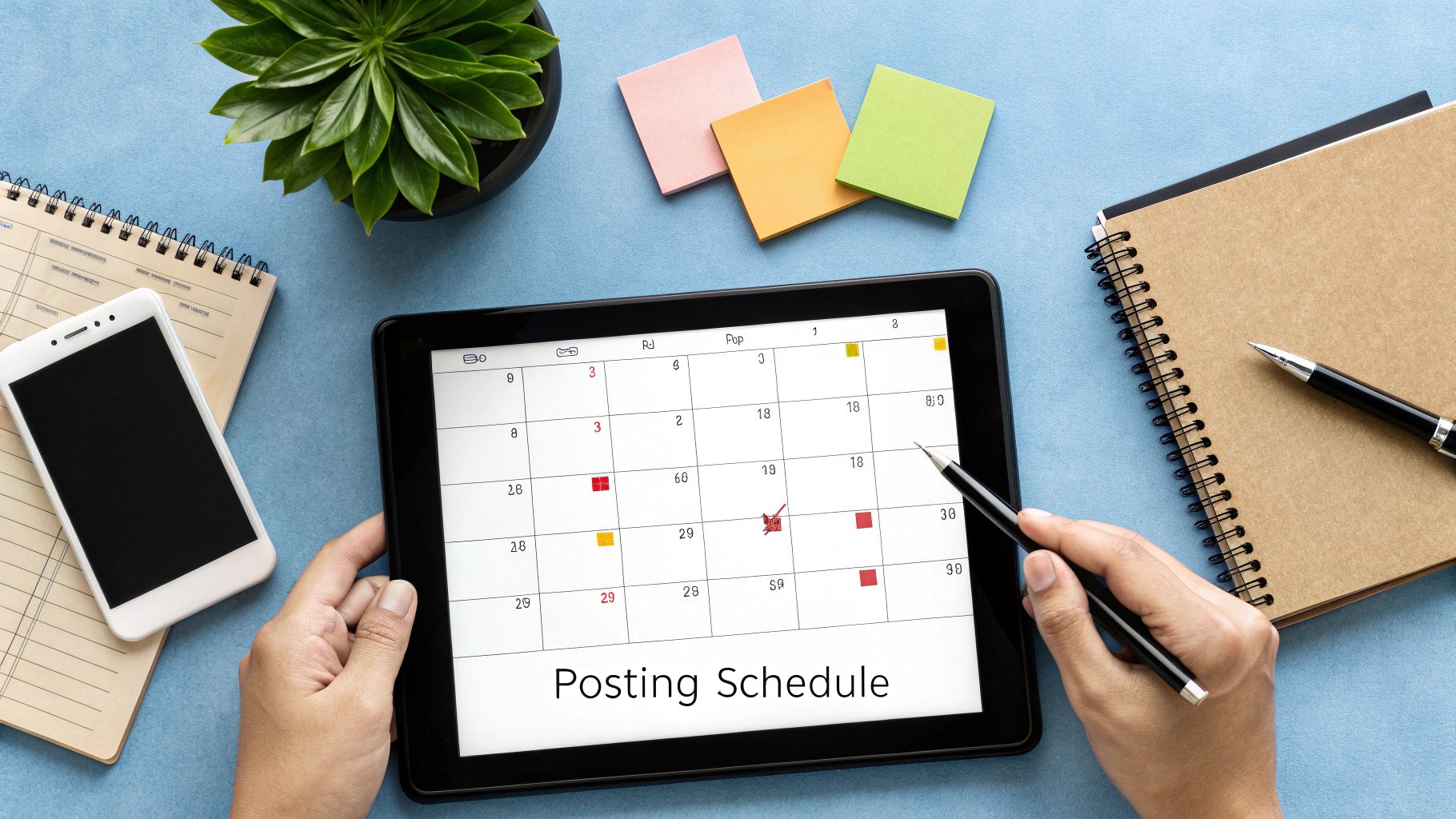A social media content calendar is your master plan for what you'll post, where you'll post it, and when. It’s the simple tool that takes you from a frantic, last-minute scramble to a thoughtful, organized marketing machine. This isn't just about being active—it's about being effective.
Go Beyond Random Posts: Why a Calendar is Non-Negotiable
Let's be real. Posting on the fly isn't a strategy. It's just a recipe for inconsistent messaging, burnout, and a whole lot of missed opportunities. When you don't have a plan, social media feels like a daily chore, not a powerful tool for growing your business. You end up throwing content at the wall to see what sticks, and that rarely aligns with your actual goals.
Think about a small online boutique trying to get noticed. One day they share a slick product photo, the next day a random meme, and then radio silence for a week. This kind of chaotic activity doesn't just look unprofessional; it confuses their followers and completely dilutes their brand.
Now, imagine that same boutique with a content calendar. They can intentionally plan a series of posts to build hype for a new product launch. They can schedule customer testimonials to go out every Friday. They can create a beautiful, cohesive look for their entire feed. Suddenly, every single post has a clear purpose.
A calendar turns your social feed from a collection of isolated updates into a compelling brand story that unfolds over time, building anticipation and loyalty with every post.
This structured approach is what separates the brands that thrive from those that just make noise online. A well-maintained calendar ensures your content is always:
- Consistent: A regular posting cadence keeps your audience hooked and your brand top-of-mind.
- Goal-Oriented: Every post can be directly tied to a marketing objective, whether that's driving website traffic, generating leads, or boosting sales.
- Collaborative: Your whole team can work in sync. Everyone has a clear view of what’s being created, what needs approval, and when it goes live.
By mapping out your content across different platforms, you create a steady stream of valuable posts that directly support your long-term marketing vision. This is a foundational part of any winning social media strategy. Making the switch from chaotic posting to planned execution is what it takes to win on social media today.
Picking the Right Tools for Your Social Media Calendar
Finding the perfect tool for your social media content calendar can feel like a huge task, but it really just comes down to your team's size, your budget, and how you like to work. There’s no magic bullet—the "best" tool is simply the one that makes your life easier.
For freelancers, startups, or small teams just getting their feet wet, you can't go wrong with free, accessible options. A simple Google Sheets spreadsheet is a fantastic starting point. It's completely free, endlessly customizable, and perfect for tracking the basics: publish dates, platforms, copy, and maybe an approval checkbox. Another great free option is Trello. Its visual, card-based system is brilliant for moving a post from an "idea" in one column to "published" in another.
When to Upgrade From the Basics
At some point, as your social media efforts scale up or your team expands, you'll likely hit the limits of a simple spreadsheet. That's when it makes sense to look at more powerful platforms. Tools like Asana are built for complex project management, while specialized solutions like CoSchedule are designed specifically for marketing and content workflows.
Think of it this way: a marketing agency juggling a dozen clients needs the detailed task assignments and reporting you get with a tool like Asana to keep everything organized. For a local coffee shop owner, however, that level of complexity would just be a headache.
The real win isn't finding the tool with the most bells and whistles. It's about finding the one that smooths out your creative process and saves you from future chaos.
The proof is in the results. A well-organized calendar isn't just about being tidy; it directly impacts your performance by helping you produce more consistent, high-quality content.

As you can see, getting organized can lead to a massive 65% jump in engagement. It’s not just about scheduling; it’s about being more strategic.
Social Media Content Calendar Tool Comparison
To help you narrow down the options, I've put together a quick comparison of some of the most popular tools people use to manage their content calendars. This table breaks down what each one does best, so you can see which aligns with your needs.
| Tool | Best For | Key Features | Price Point |
|---|---|---|---|
| Google Sheets | Solo creators & small teams on a budget | Fully customizable, easy to share, no cost. | Free |
| Trello | Visual planners & small teams | Kanban boards, drag-and-drop tasks, simple collaboration. | Free & Paid Tiers |
| Asana | Agencies & larger marketing teams | Advanced project management, task dependencies, integrations. | Free & Paid Tiers |
| CoSchedule | All-in-one social media management | Direct scheduling, AI content creation, analytics dashboard. | Free & Paid Tiers |
Ultimately, the right choice depends on your specific situation. Don't be afraid to start with a free tool and upgrade later as your needs evolve. The most important thing is to pick a system and stick with it.
Building Your Content Pillars for Engagement

A top-tier social media calendar isn't just a schedule—it’s a strategic plan built on what we call content pillars. These are the handful of core themes you’ll return to again and again. Think of them as the foundational topics that define your brand's conversation with its audience.
Having solid content pillars is what keeps your feed from becoming a monotonous stream of sales pitches. Instead of scrambling for ideas, you simply rotate through your established pillars. This system not only makes your life easier but also teaches your audience what kind of value you offer, which keeps them coming back.
Key Content Pillars to Consider
You don't need dozens of themes. Start with three to five core pillars that truly resonate with your brand and what your audience cares about. This creates a balanced, interesting content mix.
Here are a few proven pillars that work wonders across different industries:
-
Educational Content: This is your chance to teach. When you share useful information—how-tos, tips, industry insights—you position yourself as a go-to expert. It’s a powerful way to build trust. A software company, for instance, might share a quick video tutorial on a little-known but powerful feature.
-
Behind-the-Scenes Glimpses: People do business with people, not logos. This pillar is all about pulling back the curtain. Introduce your team, show how a product is made, or share a day in the life at your office. This human element is incredibly magnetic and hard for competitors to copy.
A well-structured set of content pillars ensures you’re not just selling a product but are building a community around shared interests and values. It’s the secret to sustainable social media growth.
-
User-Generated Content (UGC): Your happiest customers are your best marketers. Featuring their posts is powerful social proof. A local coffee shop could repost a beautiful photo a customer snapped of their latte art (with credit, of course!). It’s a win-win: your customer feels celebrated, and you get authentic marketing material.
-
Community Interaction: This pillar is all about engagement. Spark a conversation by asking a thought-provoking question, run a poll, or share an inspiring story from one of your followers. It’s about making your social space a two-way street.
Once you define these pillars, filling your social media content calendar becomes a systematic process, not a daily panic. Every post has a clear purpose, contributing to a more engaging experience for your followers. To get the most out of this strategy, you'll want to master the unique aspects of each social media platform, as what works on Instagram might need a different spin for LinkedIn.
Mapping Out Your Posting Cadence and Key Dates

Timing is everything in social media. It’s not just one small piece of your strategy; it’s the engine that powers visibility and engagement. A solid posting cadence is what gets your carefully crafted content in front of people who will actually interact with it. This is where your social media calendar truly starts to shine.
But finding the right rhythm is more than just sticking to a schedule. It’s about creating a flow that feels right for your team and, more importantly, your audience. The goal is consistent visibility—enough to stay top-of-mind, but not so much that you overwhelm followers or burn out your content team. You have to look beyond just your own campaign-specific posts.
Weave in Relevant Cultural Moments
Your calendar should be a roadmap of key dates that resonate with your audience. This goes beyond major holidays to include industry events, awareness days, and seasonal trends that matter to your community. A truly effective social media content calendar uses these moments to spark genuine conversation and connection.
For instance, events like World AIDS Day on December 1 or International Volunteer Day on December 5 give brands a chance to connect on a much deeper, more authentic level. From what I've seen, posts tied to meaningful causes almost always see higher interaction because people are drawn to content that reflects their values. Planning for these dates ahead of time lets you join important conversations thoughtfully, not as an afterthought.
Don’t just post about an awareness day; connect it directly to your brand’s values or actions. For a B2B tech company, this could mean highlighting how your software supports non-profits on International Volunteer Day.
Determine Your Optimal Posting Frequency
I get this question all the time: "How often should I post?" The honest answer is, there's no magic number. A hotel brand on Instagram might need daily, visually stunning posts to stay relevant. On the other hand, a B2B tech company on LinkedIn could see far better results with just three deeply insightful posts per week.
Your posting cadence should be a balance between two critical factors:
- Platform norms: What works on TikTok is completely different from what’s expected on LinkedIn. Each platform has its own culture.
- Your resources: This is a big one. Be realistic. It's always better to share three amazing pieces of content a week than seven rushed, mediocre ones.
Analyzing your own performance data is the best way to fine-tune your frequency. But if you're just starting out, you can lean on established benchmarks to get going. Knowing the best times to post on each platform gives you a huge advantage from day one. You can check out our guide on the best times to post for a detailed breakdown.
Making Your Content Workflow Actually Work

An idea parked in your content calendar is one thing. Turning it into a live, engaging post without the 11th-hour panic? That’s where the real work—and the real magic—happens. A smooth workflow is what connects your brilliant plan to the finished product, making sure every piece of content flows from concept to creation to scheduling without a hitch.
One of the biggest game-changers for me, personally, has been content batching. It’s a beautifully simple concept. Instead of scrambling to create a post from zero every day, you block out time to tackle similar tasks all at once.
Think about it: Monday morning could be for writing all of this week's captions. Then, maybe Tuesday afternoon is dedicated to designing all the graphics or editing the videos to go with them. This stops the constant mental gear-shifting and lets you find a real creative rhythm. You’d be shocked at how much time you get back.
Why Clear Statuses and Approvals Matter
As you build out this process, you need to define the journey of each post right inside your calendar. Think of these stages, or statuses, as traffic signals. They let everyone on your team see a post's status at a glance.
A simple workflow with clear approval steps is your best defense against costly mistakes, like posting unapproved copy or using the wrong image. It keeps everyone aligned and accountable.
Here’s a common, battle-tested workflow you can steal and adapt:
- Idea: The raw concept for a post.
- Drafting: The copy and visuals are actively being worked on.
- Pending Review: It’s finished and waiting for a final look-over.
- Approved: All good! It's cleared for takeoff.
- Scheduled: Locked, loaded, and in your publishing tool.
By setting up these clear stages, your calendar becomes more than just a schedule—it’s now a living, breathing project management hub. A team member can quickly spot which posts need their input, which prevents those frustrating bottlenecks and keeps the content engine running. Ultimately, this structure frees you up to focus on the fun part: actually talking to your community.
Turning Your Calendar into a Performance Tool
A great social media content calendar is more than just a schedule. It’s a living, breathing document that holds the keys to your growth. When you stop seeing it as a static to-do list and start treating it as a performance tool, you create a powerful feedback loop that makes your entire strategy smarter over time.
So, how do you make this happen? It’s simpler than you might think. Just add a few new columns to your calendar template to track core metrics for every single post.
You don't need to get lost in a sea of data. Stick to the essentials:
- Reach
- Engagement Rate
- Clicks
At the end of each month, set aside some dedicated time for a review. This isn't about judging your past efforts; it's about genuine discovery. Go through your calendar, highlight your best-performing posts, and start looking for patterns. Did videos get more love than static images? Did one of your content pillars drive way more clicks than the others? This is how raw data becomes a roadmap for what to do next.
Using Data to Guide Your Next Moves
This monthly check-in is where the magic really happens, helping you fine-tune everything from your content mix to your posting frequency. You might find that your audience is way more active on certain days or responds better to specific types of content.
For instance, some businesses thrive on high-frequency posting. A local restaurant might share new content 11.9 times per week on Instagram, while a construction company sees better results with around 7.3 posts. Your own calendar metrics will reveal your unique sweet spot for hitting peak engagement. You can find more industry benchmarks on Hootsuite's blog.
Your data tells a story. The goal is to listen to that story and use it to write the next chapter of your social media strategy, ensuring every post is more effective than the last.
This data-first mindset is the bedrock of sustainable growth. By pinpointing what truly connects with your audience, you can confidently double down on what works and stop wasting time on what doesn't. This is fundamental to how to build a social media strategy that actually drives results.
Answering Your Big Calendar Questions
Even the most seasoned social media managers run into a few recurring questions when managing their content calendars. Let's tackle some of the most common ones I hear, so you can keep your strategy moving forward without a hitch.
How Far Ahead Should I Actually Plan?
This is the classic question, and my go-to answer is to aim for one month in advance for your day-to-day content. This strikes the right balance. It gives your team enough breathing room to create thoughtful, high-quality posts without locking you into a plan so rigid you can't jump on a trending topic.
However, for your big-ticket items—think major product launches, seasonal campaigns, or annual sales events—you need a much longer runway. I always advise clients to start mapping these out two to three months ahead. This gives everyone, from design to copy to legal, ample time to coordinate and deliver their best work without the last-minute chaos.
What Happens When a Scheduled Post Suddenly Feels Wrong?
It happens to all of us. A major news story breaks or the online mood shifts, and that fun, lighthearted post you had scheduled for tomorrow suddenly feels tone-deaf. The answer is simple: pull it immediately.
This is precisely why your calendar is more than just a schedule; it’s a strategic tool.
A great content calendar isn't set in stone. It's a living document. The smartest thing you can do is build a small backlog of approved, 'evergreen' posts that you can swap in anytime.
Having this backup content ready means you can pivot in an instant without a single moment of panic.
How Can I Systemize User-Generated Content?
User-generated content (UGC) is pure gold for engagement, but you can't just grab it and post it. You need a simple, repeatable process. I recommend dedicating one of your content pillars or theme days specifically to featuring your community.
Here’s a simple workflow:
- When you find a great post from a customer or fan, save it directly to a dedicated folder in your cloud storage or a specific board in your project management tool.
- Before it ever touches your calendar, you must reach out to the creator for their explicit permission to reshare it. This is non-negotiable.
- Once you get the green light, then you can schedule it. Make sure you clearly and enthusiastically credit them in the caption!
Ready to stop juggling spreadsheets and start building a smarter, more efficient workflow? Zowa is an all-in-one platform that makes creating, scheduling, and analyzing your social media content feel effortless. Try Zowa for free and take control of your calendar today!